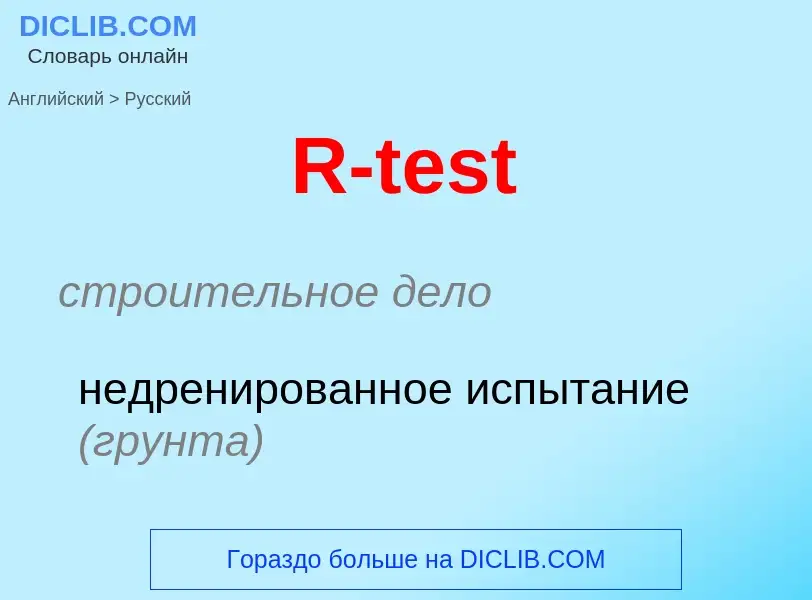Перевод и анализ слов искусственным интеллектом ChatGPT
На этой странице Вы можете получить подробный анализ слова или словосочетания, произведенный с помощью лучшей на сегодняшний день технологии искусственного интеллекта:
- как употребляется слово
- частота употребления
- используется оно чаще в устной или письменной речи
- варианты перевода слова
- примеры употребления (несколько фраз с переводом)
- этимология
R-test - перевод на русский
строительное дело
недренированное испытание (грунта)
[ɑ:]
общая лексика
вч
радиоизлучение
радиоимпульс
радиочастотный
существительное
общая лексика
18-я буква английского алфавита
восемнадцатая буква англ. алфавита
[ɑ:]
общая лексика
are
аббревиатура, принятая в электронной почте, например U R wrong
существительное
[ɑ:]
общая лексика
18-я буква английского алфавита
(категория) R
фильмы
на которые дети до 16-17 лет допускаются только в сопровождении взрослых
кинематография
([сокр.] от restricted)
Определение
Википедия

Statistics (from German: Statistik, orig. "description of a state, a country") is the discipline that concerns the collection, organization, analysis, interpretation, and presentation of data. In applying statistics to a scientific, industrial, or social problem, it is conventional to begin with a statistical population or a statistical model to be studied. Populations can be diverse groups of people or objects such as "all people living in a country" or "every atom composing a crystal". Statistics deals with every aspect of data, including the planning of data collection in terms of the design of surveys and experiments.
When census data cannot be collected, statisticians collect data by developing specific experiment designs and survey samples. Representative sampling assures that inferences and conclusions can reasonably extend from the sample to the population as a whole. An experimental study involves taking measurements of the system under study, manipulating the system, and then taking additional measurements using the same procedure to determine if the manipulation has modified the values of the measurements. In contrast, an observational study does not involve experimental manipulation.
Two main statistical methods are used in data analysis: descriptive statistics, which summarize data from a sample using indexes such as the mean or standard deviation, and inferential statistics, which draw conclusions from data that are subject to random variation (e.g., observational errors, sampling variation). Descriptive statistics are most often concerned with two sets of properties of a distribution (sample or population): central tendency (or location) seeks to characterize the distribution's central or typical value, while dispersion (or variability) characterizes the extent to which members of the distribution depart from its center and each other. Inferences on mathematical statistics are made under the framework of probability theory, which deals with the analysis of random phenomena.
A standard statistical procedure involves the collection of data leading to a test of the relationship between two statistical data sets, or a data set and synthetic data drawn from an idealized model. A hypothesis is proposed for the statistical relationship between the two data sets, and this is compared as an alternative to an idealized null hypothesis of no relationship between two data sets. Rejecting or disproving the null hypothesis is done using statistical tests that quantify the sense in which the null can be proven false, given the data that are used in the test. Working from a null hypothesis, two basic forms of error are recognized: Type I errors (null hypothesis is falsely rejected giving a "false positive") and Type II errors (null hypothesis fails to be rejected and an actual relationship between populations is missed giving a "false negative"). Multiple problems have come to be associated with this framework, ranging from obtaining a sufficient sample size to specifying an adequate null hypothesis.
Statistical measurement processes are also prone to error in regards to the data that they generate. Many of these errors are classified as random (noise) or systematic (bias), but other types of errors (e.g., blunder, such as when an analyst reports incorrect units) can also occur. The presence of missing data or censoring may result in biased estimates and specific techniques have been developed to address these problems.


![open source statistical package]] open source statistical package]]](https://commons.wikimedia.org/wiki/Special:FilePath/Gretl screenshot.png?width=200)
![Bernoulli's ''[[Ars Conjectandi]]'' was the first work that dealt with [[probability theory]] as currently understood. Bernoulli's ''[[Ars Conjectandi]]'' was the first work that dealt with [[probability theory]] as currently understood.](https://commons.wikimedia.org/wiki/Special:FilePath/Jakob Bernoulli.jpg?width=200)
![[[Karl Pearson]], a founder of mathematical statistics. [[Karl Pearson]], a founder of mathematical statistics.](https://commons.wikimedia.org/wiki/Special:FilePath/Karl Pearson, 1910.jpg?width=200)

![Letter ''R'' from the alphabet by [[Luca Pacioli]], in ''[[De divina proportione]]'' (1509) Letter ''R'' from the alphabet by [[Luca Pacioli]], in ''[[De divina proportione]]'' (1509)](https://commons.wikimedia.org/wiki/Special:FilePath/Luca Pacioli, De divina proportione, Letter R.jpg?width=200)

![The word ''prognatus'' as written on the [[Sarcophagus of Lucius Cornelius Scipio Barbatus]] (280 BC) reveals the full development of the Latin ''R'' by that time; the letter ''P'' at the same time still retains its archaic shape distinguishing it from Greek or Old Italic ''rho''. The word ''prognatus'' as written on the [[Sarcophagus of Lucius Cornelius Scipio Barbatus]] (280 BC) reveals the full development of the Latin ''R'' by that time; the letter ''P'' at the same time still retains its archaic shape distinguishing it from Greek or Old Italic ''rho''.](https://commons.wikimedia.org/wiki/Special:FilePath/Prognatus.png?width=200)
